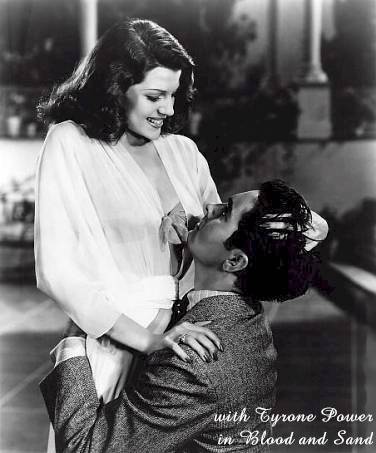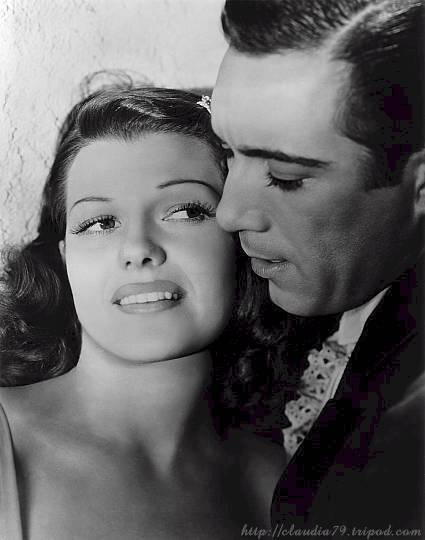 Blood and Sand (1941)
Blood and Sand (1941)A 20th Century-Fox Picture
Producer: Darryl F. Zannuck
Screenplay: Jo Swerling, from novel,
The Stars:
Song: "Verde luna," by Vicente Gómez
Miss Hayworth's dubbing: Graciela Párranga
Color, 125 mins. running time |
 Blood and Sand (1941)
Blood and Sand (1941)A 20th Century-Fox Picture
Producer: Darryl F. Zannuck
Screenplay: Jo Swerling, from novel,
The Stars:
Song: "Verde luna," by Vicente Gómez
Miss Hayworth's dubbing: Graciela Párranga
Color, 125 mins. running time |
| After six years and more than thirty films, the success of Blood and Sand brought Rita to international stardom. When casting for the picture, Fox tested dozens of young actresses for the choice part of Doņa Sol, including Maria Montez and Gene Tierney. The director, Rouben Mamoumlian, recalled "the moment I saw Rita Hayworth walk I knew I had my Doņa Sol...I was not the least surprised when she later became one of the great screen sirens." Blood and Sand was first made in 1922 with Rudolph Valentino as the young bullfighter and Nita Naldi as Doņa Sol. Valentino was replaced by handsome Tyrone Power in this version. Power actually wanted to do some of his own bullfighting sequences, but the studio would not allow it. He learned to do the capework for closeups, but in long shots it is, of course, a stand-in.
Blood and Sand opens with Juan Gallardo (Tyrone Power) as a young boy. Along with friends from his home hometown in Sevilla, he journeys to Madrid in hopes of entering the world of bullfighting. They return ten years later, Juan now an up-and-coming matador, and his friends his quadrilla. Upon his return, Juan reunites with his childhood sweetheart, Carmen Espinosa (Linda Darnell), who has been waiting for him all these years. They are married and soon after, Juan's dream comes to fruition. He becomes the greatest matador in all of Spain.
All is well until the beautiful temptress, Doņa Sol (Rita Hayworth) enters his life. She sets her sights on him and Juan finds himself torn between his loving wife and the luscious femme fatale. Eventually he can no longer resist Doņa Sol, and succumbs to her charms. Soon his affair with her begins to take a toll on his career. His skill in bullring begins to slip and his new attitude drives away his once faithful friends.
Inevitably, Doņa Sol tires of Juan and turns her attention to up and coming matador, Manolo de Palma (Anthony Quinn). The passing of this titian-haired torch marks de Palma as the next superstar of the Spanish bullring. Juan continues on his downward spiral until the ever-devoted Carmen returns to him. She tells him that she'd never actually left, that she'd always watched over him and prayed that he would survive another afternoon in the ring. Her love renews Juan's confidence. He enters the bullring once more, saying it'll be his last time before retiring to be with Carmen. In a blaze of glory, he performs like his old self again. The crowd goes wild. Then suddenly he is caught off guard and is gored by the bull. A brave Carmen declares that to her, he'll never really die. The spirit of her "Juanillo" will remain with her all the days of her life.
Rita's gives a standout performance, in this, her first Technicolor production. "Doņa Sol" was a star-making type of role and she played it for all its worth. She was appearing alongside Tyrone Power on the screen, but off screen at the time, Rita was stepping out with the second male lead, Anthony Quinn. Together they performed one of the steamiest dance routines of her film career. She also "sang" "Verde Luna," a lovely song but Fox's choice to provide the vocals, Graciela Párranga, was perhaps the most unsuited to Rita of all her song-dubbers. Working under the direction of Rouben Mamoulian, the cast and crew made Blood and Sand one of the best films of the year. It won the Academy Award for "Best Color Cinematography" of 1941 and was also nominated for "Best Interior Set Decoration". |
